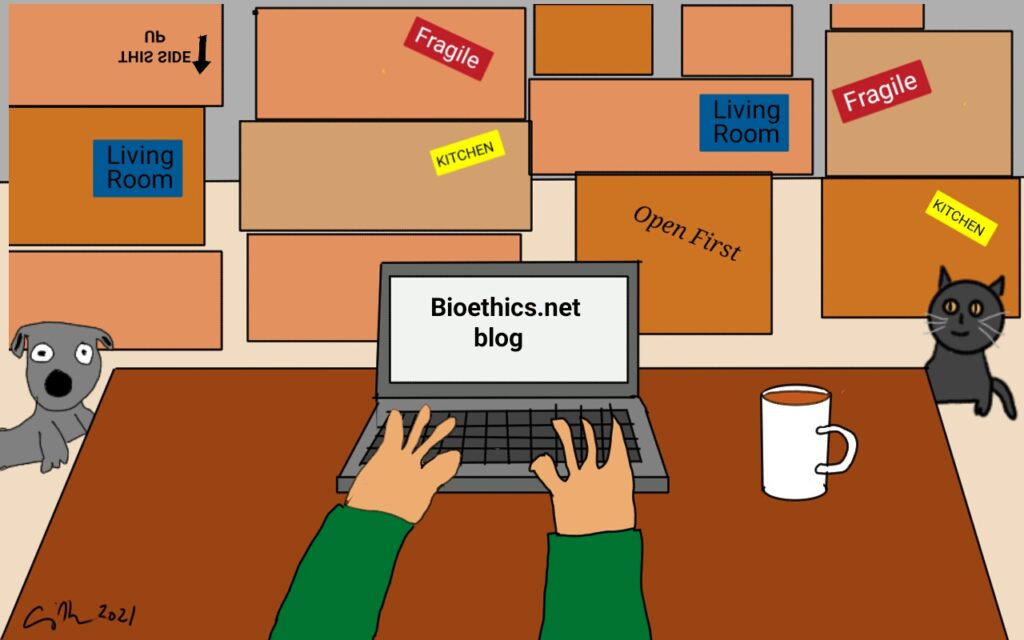“One Last Time”
by Craig Klugman, Ph.D.
One of the traditions of this blog has been an end-of-year recap and offering of predictions for the new year. Like most things in 2020, however, this year’s review will be a little different. While I am writing the end of the year post, the look forward is being written by the new co-editors of the blog, Keisha Ray and Alyssa Burgart.
In 2012, two colleagues and friends arranged a shidduch between myself and David Magnus, editor-in-chief of The American Journal of Bioethics. Before attending graduate school, I had worked for many years as a journalist and thought of bringing that experience into my bioethics activities by writing a blog. At the same time, David had been thinking about relaunching the bioethics.net blog. My hope was to create an outlet of accessible, original scholarly work that was brief and geared toward a non-specialized reader. I wanted essays that could be read and understood by students, policy makers, journalists, and of course, bioethicists. The writing was to be academically rigorous, informative, and with a call to action—each piece would ask the reader to do something or to consider a new perspective. A good blog grabs your attention, makes an argument supported with strong evidence, and then asks you to act, often to improve social justice in the world. I wanted the writers to own their work and to feel empowered to share their viewpoints.

In the eight plus years since then, I have written nearly 500 original blog posts, edited countless guest essays, mentored scholars in blog/OpEd writing, organized a blog editor panel at ASBH, launched columns on television and film as well as co-developed our COVID-19 and #BlackBioethics resource pages. I have had “tips” sent to me by people all over the world that led to some investigative reporting pieces. I have been interviewed by reporters on television, radio, newspapers, and online venues based on something they found interesting in a blog post. Pieces addressed health policy, gave advice to students, and took a critical lens to the field of bioethics. A few years ago, to encourage eyeballs on our social media posts, we decided to include more graphics and given that we work with a budget of $0, I jumped off the cliff of comic making. These original works of art tell a story about bioethics in a single frame (You can see pieces at graphicbioethics.com). The blog gave me a place to explore and share this art form which has evolved into #artforthecovidpandemic and the #covidcrumbtinies.
As The OpEd Project founder Katie Orenstein is fond of saying, “If you say something of consequence, there will be consequences. The alternative is to be inconsequential.” Thus, with the good there has been some bad. I have had my share of threats from readers who disagreed strongly, including several letters sent to my university presidents asking them to take action against me for what I wrote. One piece that supported Planned Parenthood received condemnation from conservative Catholic groups who wondered how a Catholic university could employ me. Another lambasted me for “wanting people to die” when I took issue with unapproved and experimental use of hydroxychloroquine in vulnerable (i.e. nursing home) populations without their knowledge or consent. My administration always supported me.
The great advantages to a blog are that it can be easily understood, consumed in one sitting, easily shared, and are timely—publication happens within hours, not months or years. A good blog is responsive to the world around us. 2020 showed the need for bioethics in our public conversations. Since March, I do not think there has been more than a handful of posts that have not dealt with the pandemic or racial injustice. The blog has encouraged bioethics to look inward and see its own problems as well from a lack of racial and ethnic diversity in our ranks to a worship of autonomy and individualism that pushed public health ethics to the margins and has failed us in our current health crisis.
As David pointed out to me last month, I have been really doing two jobs for the blog: (1) Regular columnist writing 1-3 articles per week (of 1,000- 1,600 words each post) and (2) editor – maintaining the content on the site, pushing essays out through social media, editing others’ essays, mentoring writers, and encouraging writers to post with us. And I have loved most minutes of this work. For me personally, 2020 was a year of transition. I write this surrounded by boxes as I have moved into a new home by myself. Thus, this seems an opportune time to look toward new projects and possibilities.
I have always felt that the true sign of success of an endeavor whether that be a center, program, or a blog is its ability to continue strongly after current leadership steps away. Toward that end, the blog invited Keisha Ray to join us a few years ago as co-editor. And now she will take over the as the blog senior editor, assisted by the remarkable Alyssa Burgart.
I hope that this blog has managed to make bioethics more accessible to a public audience. I hope that it has inspired others in their work and teaching and that it has stimulated many great conversations. I hope that it continues to serve as bioethics’ portal into the greater world.